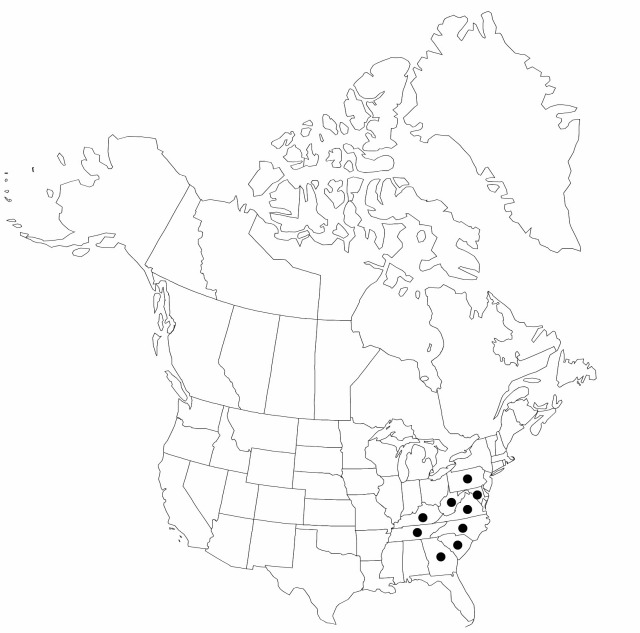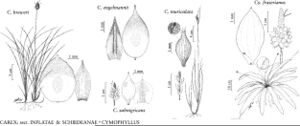Difference between revisions of "Cymophyllus fraserianus"
Rhodora 93: 138. 1991.
FNA>Volume Importer |
imported>Volume Importer |
||
| (6 intermediate revisions by 2 users not shown) | |||
| Line 7: | Line 7: | ||
|year=1991 | |year=1991 | ||
}} | }} | ||
| − | |basionyms={{Treatment/ID/ | + | |special_status={{Treatment/ID/Special_status |
| + | |code=F | ||
| + | |label=Illustrated | ||
| + | }}{{Treatment/ID/Special_status | ||
| + | |code=E | ||
| + | |label=Endemic | ||
| + | }} | ||
| + | |basionyms={{Treatment/ID/Basionym | ||
|name=Carex fraserianus | |name=Carex fraserianus | ||
|authority=Ker Gawler | |authority=Ker Gawler | ||
| + | |rank=species | ||
| + | |publication_title=Bot. Mag. | ||
| + | |publication_place=34: plate 1391. 1811 | ||
}} | }} | ||
|synonyms={{Treatment/ID/Synonym | |synonyms={{Treatment/ID/Synonym | ||
|name=Carex fraseri | |name=Carex fraseri | ||
|authority=Andrews | |authority=Andrews | ||
| − | }}{{Treatment/ID/Synonym | + | |rank=species |
| + | }} {{Treatment/ID/Synonym | ||
|name=Cymophyllus fraseri | |name=Cymophyllus fraseri | ||
|authority=(Andrews) Mackenzie | |authority=(Andrews) Mackenzie | ||
| + | |rank=species | ||
}} | }} | ||
|hierarchy=Cyperaceae;Cymophyllus;Cymophyllus fraserianus | |hierarchy=Cyperaceae;Cymophyllus;Cymophyllus fraserianus | ||
| Line 31: | Line 43: | ||
|habitat=Mesic to wet- mesic, shaded slopes and banks in rich, often rocky deciduous, mixed, or hemlock forests, local, often abundant | |habitat=Mesic to wet- mesic, shaded slopes and banks in rich, often rocky deciduous, mixed, or hemlock forests, local, often abundant | ||
|elevation=400–1300 m | |elevation=400–1300 m | ||
| − | |distribution=Ga.;Ky.;Md.;N.C.;Pa.;S.C.;Tenn.;Va. W.Va. | + | |distribution=Ga.;Ky.;Md.;N.C.;Pa.;S.C.;Tenn.;Va.;W.Va. |
| − | |discussion=<p>The broad, straplike leaf of Cymophyllus, apparently lacking a midvein, sheath, and ligule and with finely undulate margins, is unique in Cyperaceae. This southern Appalachian endemic (R. B. Clarkson 1962) is presumably a relict, sharing the same ancestry as Carex, and has evolved the flat, “blade” of its leaf from an expanded bladeless sheath (A. A. Reznicek 1989). Both the morphology of the inflorescence and preliminary observations (W. W. Thomas 1984b) suggest the plant is entomophilous. Some individuals in populations are protandrous, and others are protogynous, but details of the reproductive biology of this species are unknown. Cymophyllus is a striking plant with its broad, evergreen leaves and gleaming white inflorescences, and it is sometimes cultivated in woodland wildflower gardens.</p> | + | |discussion=<p>The broad, straplike leaf of <i>Cymophyllus</i>, apparently lacking a midvein, sheath, and ligule and with finely undulate margins, is unique in Cyperaceae. This southern Appalachian endemic (R. B. Clarkson 1962) is presumably a relict, sharing the same ancestry as <i>Carex</i>, and has evolved the flat, “blade” of its leaf from an expanded bladeless sheath (A. A. Reznicek 1989). Both the morphology of the inflorescence and preliminary observations (W. W. Thomas 1984b) suggest the plant is entomophilous. Some individuals in populations are protandrous, and others are protogynous, but details of the reproductive biology of this species are unknown. <i>Cymophyllus</i> is a striking plant with its broad, evergreen leaves and gleaming white inflorescences, and it is sometimes cultivated in woodland wildflower gardens.</p> |
|tables= | |tables= | ||
|references= | |references= | ||
| Line 41: | Line 53: | ||
-->{{#Taxon: | -->{{#Taxon: | ||
name=Cymophyllus fraserianus | name=Cymophyllus fraserianus | ||
| − | |||
|authority=(Ker Gawler) Kartesz & Gandhi | |authority=(Ker Gawler) Kartesz & Gandhi | ||
|rank=species | |rank=species | ||
| Line 51: | Line 62: | ||
|habitat=Mesic to wet- mesic, shaded slopes and banks in rich, often rocky deciduous, mixed, or hemlock forests, local, often abundant | |habitat=Mesic to wet- mesic, shaded slopes and banks in rich, often rocky deciduous, mixed, or hemlock forests, local, often abundant | ||
|elevation=400–1300 m | |elevation=400–1300 m | ||
| − | |distribution=Ga.;Ky.;Md.;N.C.;Pa.;S.C.;Tenn.;Va. W.Va. | + | |distribution=Ga.;Ky.;Md.;N.C.;Pa.;S.C.;Tenn.;Va.;W.Va. |
|reference=None | |reference=None | ||
|publication title=Rhodora | |publication title=Rhodora | ||
|publication year=1991 | |publication year=1991 | ||
| − | |special status= | + | |special status=Illustrated;Endemic |
| − | |source xml=https:// | + | |source xml=https://bitbucket.org/aafc-mbb/fna-data-curation/src/2e0870ddd59836b60bcf96646a41e87ea5a5943a/coarse_grained_fna_xml/V23/V23_1097.xml |
|genus=Cymophyllus | |genus=Cymophyllus | ||
|species=Cymophyllus fraserianus | |species=Cymophyllus fraserianus | ||
Latest revision as of 20:38, 5 November 2020
Culms 20–40 cm. Leaves strap-shaped, gradually tapered to base that wraps around stem, finely evenly 50–90-veined, 20–60 × 1.7–5 cm, margin finely undulate, base gradually tapered, apex broadly acute-rounded, ciliate-serrulate. Inflorescences a single androgynous spike, 1.4–2.5 × 1.1–1.5 cm; pistillate portion ± globose at maturity. Scales translucent-white. Perigynia white, becoming pale greenish at maturity, ellipsoid to broadly ellipsoid, ± inflated, circular to flattened in cross section, 4.5–6.7 × 2.2–3 mm, membranaceous; beak short, orifice entire. Stigmas thick, stiff, finely papillose. Achenes dark brown, elliptic to circular or broadly obovate in outline, 2.4–3.2 × 1.6–2.5 mm.
Phenology: Fruiting early summer (May–Jun).
Habitat: Mesic to wet- mesic, shaded slopes and banks in rich, often rocky deciduous, mixed, or hemlock forests, local, often abundant
Elevation: 400–1300 m
Distribution

Ga., Ky., Md., N.C., Pa., S.C., Tenn., Va., W.Va.
Discussion
The broad, straplike leaf of Cymophyllus, apparently lacking a midvein, sheath, and ligule and with finely undulate margins, is unique in Cyperaceae. This southern Appalachian endemic (R. B. Clarkson 1962) is presumably a relict, sharing the same ancestry as Carex, and has evolved the flat, “blade” of its leaf from an expanded bladeless sheath (A. A. Reznicek 1989). Both the morphology of the inflorescence and preliminary observations (W. W. Thomas 1984b) suggest the plant is entomophilous. Some individuals in populations are protandrous, and others are protogynous, but details of the reproductive biology of this species are unknown. Cymophyllus is a striking plant with its broad, evergreen leaves and gleaming white inflorescences, and it is sometimes cultivated in woodland wildflower gardens.
Selected References
None.
